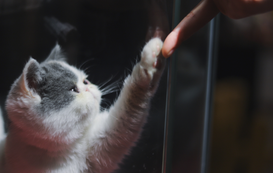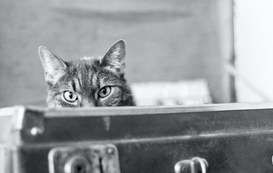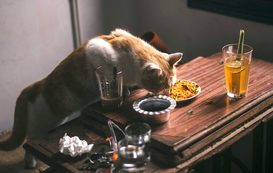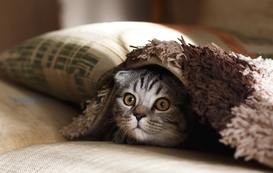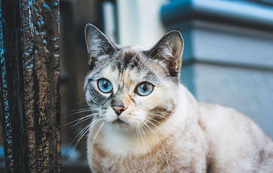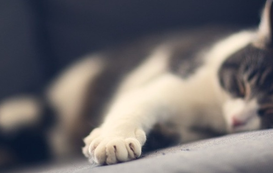Popular posts
The “Cat Days of Summer”: How to Keep Your Cat Cool During the Hot Summer Months
Summertime is a wonderful time for humans—the sun is shining, the weather is warmer, the world feels alive—but how do we make sure this time is also a fun (and safe) time for our kitty companions?
Summer can be an awesome time in your cat’s life, but it’s definitely only as enjoyable as it is safe. The heat can be very dangerous for cats, so it’s extremely important for their owners to keep a watchful eye on their furry pets during the hot summer months.
When humans are overheated, they sweat. Sweating is the body’s ingenious self-cooling system. When the human body is overheated, it causes water and fluids to secrete from the sweat glands and out of the pores on the top layer of the skin, evaporating the liquid in the hot open air and helping to regulate the body’s temperature. Unfortunately cats, unlike humans, cannot sweat when they are overheated. When cats are too hot, they will do things like pant and lick their fur. Because these are not very helpful or efficient ways of cooling their bodies, it’s actually pretty easy for cats to succumb to overheating or heat stroke. It’s important to note the difference between your kitty trying to cool off normally and your cat dangerously overheating.
Signs Your Cat is Cooling Itself Off
- Decreased activity (to reduce heat and energy expenditure)
- Laying stretched out across the floor
- Drinking water
- Seeking cool areas of the house (away from sunny windows, underneath shady furniture, into basements, etc)
- Moderate panting and fur licking
Signs Your Cat is Overheating or Experiencing Heat Stroke
- Excessive panting
- Excessive fur licking
- Discolored gums and tongue (either very pale or very red)
- Drooling
- Increased heart rate
- Extreme lethargy
- Weakness
- Confusion or delirium
- Muscle spasms or tremors
- Vomiting
- Dizziness or unsteady walking
- Non-responsiveness
If your cat is showing any signs of heat stroke, be sure to get them into a cool room as soon as possible or wrap them in a cool, damp towel. If the signs of overheating are severe, make sure to get them to a veterinarian right away.
Now that you know the signs of heat stroke and what to do if it occurs, it’s important to know how to prevent your cat from overheating altogether. Making sure your kitty is always cool and comfortable is incredibly important for their overall health and vitality, both physical and emotional.
During the summer, make sure wherever you and your kitty are living is properly cooled. The average body temperature for a cat is between 100 and 102 degrees Fahrenheit. When the outside temperature exceeds that, your cat is in great danger of overheating. Cats can also dehydrate in the heat pretty quickly, so ensuring they have constant access to cool and clean water during the summer is essential. If you’re taking your kitty for some outside adventures, make sure you’re conscious of the temperature and always be sure to have water on hand. It can get really dangerous really quick!
Grooming is also an important part of keeping your kitty comfortable in the heat. If you have a long-haired cat, be sure to keep their fur under control during the summer. Making sure they are not matted with thick knots of fur will help the heat escape their body easier. You can even take them to the groomer and get them professionally clipped or shaven. If you do decide to shave your long-haired cat for the summer, be aware that your cat will now be susceptible to sunburn, so it’s important to keep them out of direct sunlight. Their skin is very sensitive!
Keeping some cooldown essentials on hand is also a great idea. Make ice-treats (or just use plain ice cubes) for your kitties to lick on when they are feeling too warm. If it’s super hot, you can use a frozen water bottle or bag of vegetables and wrap them in a towel for your kitty to nap with. They even make cooling mats that you can keep in the fridge or freezer and bring out during the hottest parts of the day. This will help cool and relax any tired or overheated kitty!
Another important thing to consider during the summertime is your kitty’s paws. When taking your cat outside for any reason, pay attention to the terrain they are walking on. Asphalt and concrete absorb a ton of heat from the sun and can cause extremely painful burns on the soft and sensitive pads on your kitty’s paws. Consider keeping them exclusively on grass or astroturf when you’re taking your furry companion outside. You can also try protective pet booties, but be warned—most cats will not walk properly once they are on as it messes with their equilibrium and sense of balance. (If you haven’t, please YouTube some videos of cats trying to walk in booties. Seriously, you won’t regret it.)
If you live somewhere that has a lot of outdoor or feral cats, consider their needs during the summertime too. If you are able to, it’s a wonderful idea to create a cat shelter for kitties that are stuck outside during the hot and uncomfortable summer months. Giving them a chance to rest, recover, and take shelter away from the blazing hot sun is incredibly important to their health and wellbeing. Providing them with cool water as well will also prevent them from dehydrating. Even homeless kitties need protection from the sun and heat, too!
The summertime can be a really fun time for you and your kitty, but it’s super important to be conscious of how the heat affects your cat. Remember, cats respond to heat much differently than humans do, so what may not feel too hot for you could be way too hot for your kitty. Ensuring they are cool, relaxed, and comfortable will ensure that they are happy, healthy, and thriving.
Frequently Asked Questions
Q: What are the best types of cooling mats available for cats, and where can I find them?
A: When it comes to finding the best types of cooling mats for cats, there are several options available that cater to different needs and preferences. Most pet stores, both online and physical, offer a range of cooling mats designed specifically for pets. These mats typically contain gel that cools when pressure is applied, offering immediate relief for your cat. hen selecting a mat, consider its size relative to your cat and its ease of cleaning. You can find these mats at major retailers, and local pet stores.
Q: How often should long-haired cats be groomed or clipped during the summer to prevent overheating?
A: It's essential to maintain a routine that keeps your cat comfortable without overdoing it. Generally, it is recommended to brush long-haired cats several times a week to prevent matting and to help remove excess fur, which can trap heat. During the summer months, increasing the frequency of brushing can help. Some pet owners choose to have their long-haired cats clipped or professionally groomed at the onset of summer. If you opt for a full shave, be aware that your cat's skin will be more vulnerable to sunburn, so keeping them out of direct sunlight is crucial. A visit to a professional groomer every 6 to 8 weeks during the summer can be beneficial for managing your cat’s coat and comfort.
Q: Are there any specific signs that indicate my cat is enjoying or benefiting from the ice treats or cooling measures I'm using?
A: Cats that find relief through such measures may spend more time near cooling mats or show a keen interest in ice treats when offered. If your cat seems more relaxed and spends time cooling off with these aids without signs of distress, these are good indicators that the measures are effective. Conversely, if your cat ignores the cooling devices or treats, it might be necessary to try different options or approaches to find a more suitable and enjoyable cooling solution for your pet. Each cat has unique preferences, so it may take some experimentation to discover what works best for your furry friend.












